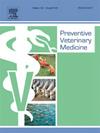Estimating waning immunity against classical swine fever virus among adult wild boar: A case study in Japan
IF 2.2
2区 农林科学
Q1 VETERINARY SCIENCES
引用次数: 0
Abstract
Bait vaccination against classical swine fever virus (CSFV) among wild boar in Japan started in 2019 and has continued so far. While the proportion of immune individuals increased in the early phase of the CSFV epidemic, this proportion tended to decrease in some regions, even after the subsequent vaccination. Turnover of wild boar populations can reduce the proportion of immune individuals; however, the decrease was also observed among adult wild boar during the season when the influence of turnover was negligible. Waning immunity is hypothesized as an alternative mechanism. This study aimed to test the hypothesis of waning immunity and estimate the waning rate among wild boar. A mathematical model describing CSFV transmission dynamics, host population dynamics, effect of vaccination, and waning immunity was constructed. We also constructed a model without waning immunity. The two models were fitted to a time-series of the proportion of recovered/vaccinated animals (i.e., ELISA-positive and PCR-negative) among adult wild boar in Gifu, Japan, assuming that the influence of turnover was negligible from July to November. The hypothesis that immunity against CSFV can wane is accepted; the model with waning immunity showed a significantly better fit compared to another model. The time until ELISA test results became negative after recovery/vaccination was estimated to be 26.6 weeks. Our results imply that the acquired immunity against CSFV and bait vaccination wanes over time. The level of herd immunity after vaccination against CSFV should be evaluated taking the waning immunity into account.
估计成年野猪对猪瘟病毒免疫力下降:以日本为例。
日本野猪针对猪瘟病毒(CSFV)的诱饵疫苗接种始于2019年,并一直持续到目前为止。虽然免疫个体的比例在CSFV流行的早期阶段有所增加,但这一比例在某些地区趋于下降,即使在随后的疫苗接种之后也是如此。野猪种群更替会降低免疫个体的比例;然而,在更替影响可以忽略不计的季节,成年野猪的死亡率也有所下降。免疫力下降被假设为另一种机制。本研究旨在检验野猪免疫力下降假说,估计野猪免疫力下降率。建立了猪瘟传播动态、宿主种群动态、接种效果和免疫减弱的数学模型。我们还建立了一个免疫能力没有减弱的模型。这两个模型拟合了日本岐阜成年野猪中恢复/接种动物(即elisa阳性和pcr阴性)比例的时间序列,假设从7月到11月的更替影响可以忽略不计。对猪瘟的免疫力可能减弱的假设被接受;与另一个模型相比,免疫力下降的模型显示出明显更好的拟合。在恢复/接种疫苗后,ELISA检测结果变为阴性的时间估计为26.6周。我们的结果表明,对猪瘟的获得性免疫和诱饵接种随着时间的推移而减弱。接种猪瘟疫苗后的群体免疫水平应考虑到免疫力下降。
本文章由计算机程序翻译,如有差异,请以英文原文为准。
求助全文
约1分钟内获得全文
求助全文
来源期刊

Preventive veterinary medicine
农林科学-兽医学
CiteScore
5.60
自引率
7.70%
发文量
184
审稿时长
3 months
期刊介绍:
Preventive Veterinary Medicine is one of the leading international resources for scientific reports on animal health programs and preventive veterinary medicine. The journal follows the guidelines for standardizing and strengthening the reporting of biomedical research which are available from the CONSORT, MOOSE, PRISMA, REFLECT, STARD, and STROBE statements. The journal focuses on:
Epidemiology of health events relevant to domestic and wild animals;
Economic impacts of epidemic and endemic animal and zoonotic diseases;
Latest methods and approaches in veterinary epidemiology;
Disease and infection control or eradication measures;
The "One Health" concept and the relationships between veterinary medicine, human health, animal-production systems, and the environment;
Development of new techniques in surveillance systems and diagnosis;
Evaluation and control of diseases in animal populations.
 求助内容:
求助内容: 应助结果提醒方式:
应助结果提醒方式:


